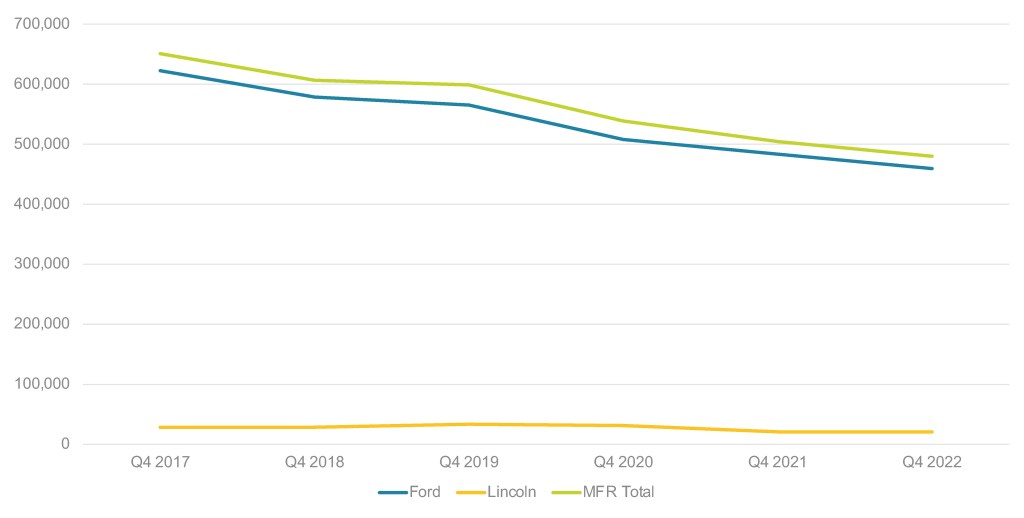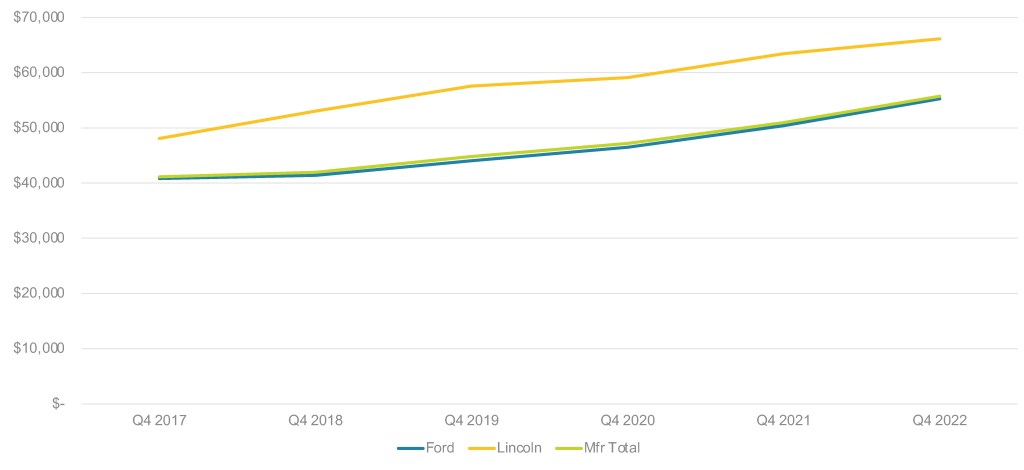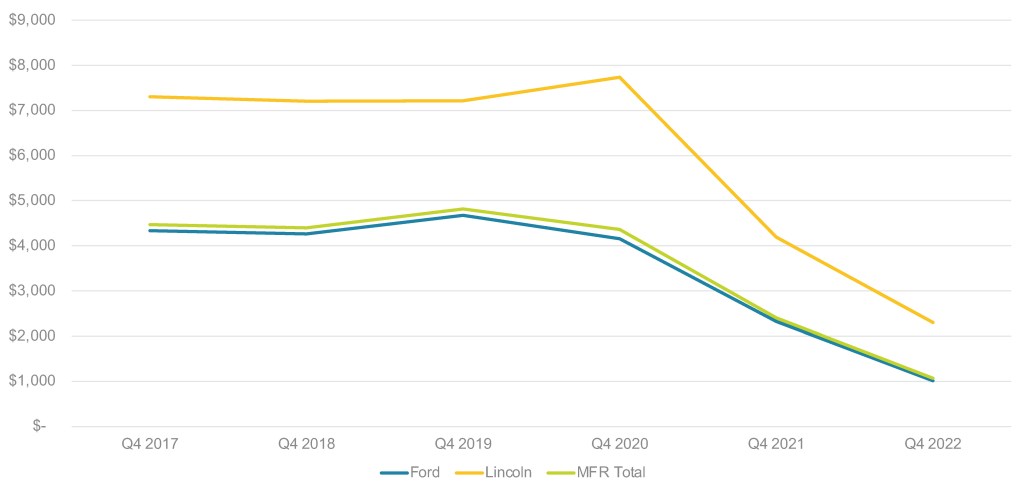Data Point
Cox Automotive Analysis: Ford Motor Company’s Q4 2022 U.S. Market Performance
Wednesday February 1, 2023
Article Highlights
- Ford vastly underperformed the U.S. market in sales, causing its market share to drop.
- Ford more than halved incentives to an average of $1,069 per vehicle.
- Ford’s average transaction price hit a new high of $55,737.
Driven in part by strength from its electric vehicles, Ford Motor Co. could deliver better-than-expected financial results for the final quarter of 2022 when it reports them on Thursday, Feb. 2, Wall Street analysts say.
Ford is forecasted to be in the black for the quarter, following the third-quarter loss caused by one-time charges tied to the dissolution of the Ford and Volkswagen backed autonomous vehicle business, Argo AI. Ford also should post significantly better results than a year ago when the global chip shortage wreaked havoc on global auto production.
Indeed, in the U.S., Ford’s newest models, many of which are available with alternative powertrains, had the heftiest sales hikes in the fourth quarter of 2022. Going forward, Ford will post results for its gas-powered business and electrified unit separately. Analysts expect Ford to provide more detail on that and its electrified vehicle strategy during its upcoming earnings call.
Still, electrified models, while growing, remain relatively small-volume vehicles. Their sales gains were not enough to offset Ford’s sales losses in some of its high-volume traditional trucks and SUVs. Ford underperformed the U.S. market in the quarter with a sales decline when the overall market was up, causing a share loss. Still, Ford was able to more than halve incentives and boost average transaction prices.
The U.S. is Ford Motor Company’s most important market. Here are some data points from Cox Automotive on its Q4 market performance.
Sales Fall as the Industry Rises
Ford Motor Co. sold 479,769 vehicles in Q4 2022, down almost 5% from the year before. It was the first time in the past six years that sales fell below the 500,000-unit mark for the quarter.
Ford Motor Company U.S. Sales Performance for Q4 2022

Ford brand accounted for the bulk of the decline. The brand sold 459,203 vehicles, down 5% and its lowest fourth quarter in at least the past six years.
Ford’s newest vehicles, some of which are available with alternative powertrains, had the heftiest sales hikes. The small Maverick pickup truck, which comes standard with a hybrid system and is optional with a gas engine, had the biggest sales increase, up 77% to 22,568 units. The Transit commercial van, which now includes an electric version, also had a hefty gain, with sales up 48% to 31,049 units. The electric Mustang Mach-E was up 37% to 11,369 units. While not an electrified model, Bronco had a sales increase of 24% to 30,670 units, as some consumers who ordered them months ago are still waiting for delivery.
Ford’s all-important F-Series, which accounts for most of Ford’s sales and profits, slipped by 2% to 186,650 trucks. Still, the F-Series was the No. 1 selling pickup truck in the U.S. for the 46th straight year. The electric version of F-Series, the Lightning, had sales near 7,000 units in the quarter, its best quarter to date. Except for the Expedition, Ford’s other long-time products had sales drops – Explorer down 14%, Bronco Sport down 27%, Escape down 16%, and Edge down 41%.
Lincoln brand sales dipped by 2% to 20,566, also its lowest sales for any fourth quarter in the past six years. Lincoln’s highest volume model, the Corsair, was the only Lincoln to have a sales hike, and it was a big one. Sales rose 28% to 7,391 units. The Nautilus had a 39% sales drop. Aviator slipped 3%.
Ford’s Underperforming the Market Lowers Share
With Ford’s total sales falling 5% when the overall market rose 9%, Ford lost 2 percentage points of share, a significant drop in the competitive U.S. market.
Ford’s total share fell to 13.3%, its second lowest for any fourth quarter in at least the past six years.
The Ford brand’s share accounted for the bulk of the decline. Its share came in at 12.7%, down 1.9 percentage points. Lincoln’s share was 0.6%, off only 0.1 percentage point compared to Q4 2021, basically a rounding difference. Lincoln’s share has ranged from 0.6% to 0.8% in recent years.
Ford Average Transaction Price Climbs to $55,737
Ford’s total average transaction price (ATP) climbed by 9% to a new high of $55,737 in Q4 2022, according to Cox Automotive calculations. Each brand had an increase to its highest level for any fourth quarter.
FORD MOTOR COMPANY U.S. AVERAGE TRANSACTION PRICE FOR Q4 2022

The Ford brand had the largest hike, up nearly 10% to $55,727. The biggest gainer was the Transit commercial van, up 15% to $54,355. F-Series also was up 10% to $65,858. Other models had single-digit increases. The electric Mustang Mach-E had an ATP of $59,431 in Q4 2022. Mach-E transaction prices are expected to drop in 2023, as Ford has confirmed plans to cut prices to help increase sales in an EV market that is growing more crowded and more competitive.
Lincoln’s ATP rose 4% to $66,134, with each model gaining slightly. The Nautilus had the biggest percentage increase, up 4% to $56,614. The Aviator, Lincoln’s priciest model, edged up to $72,680. The Corsair also edged higher to $46,427.
Ford Incentives More Than Halved
Ford Motor Co. slashed incentives by nearly 56% to an average of $1,069 per vehicle, according to Cox Automotive calculations.
FORD MOTOR COMPANY U.S. INCENTIVE SPENDING FOR Q4 2022

The Ford brand cut incentives the most, by more than 56% to an average of $1,014 per vehicle, the lowest in years. Before the chip shortage, the Ford brand typically spent more than $4,000 per vehicle on incentives.
Lincoln chopped incentives by 45% to an average of $2,301 per vehicle, also the lowest in years by a wide margin. Before the chip shortage, Lincoln typically spent an average of more than $7,000 on incentives per vehicle.
Michelle Krebs is executive analyst at Cox Automotive.
